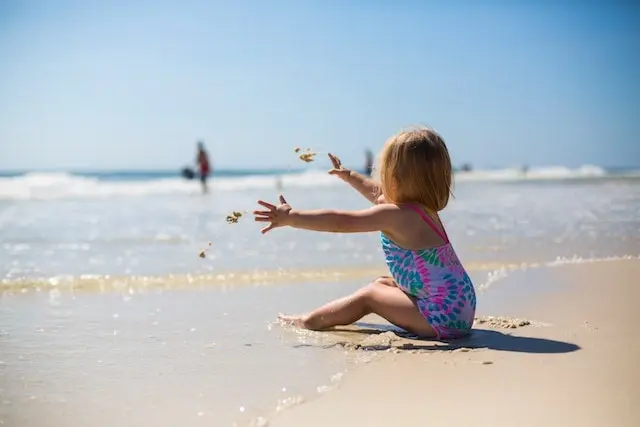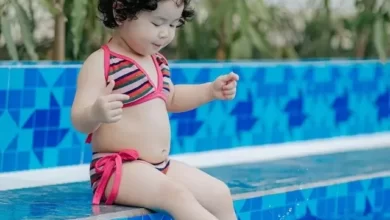Essential Strategies for Introducing Infants to Swimming Safely

The first ripples of laughter that resonate around the pool as an infant touches the water are as memorable as they are delicate—moments cherished deeply by every parent. Anticipation and cautious excitement fill the air when embarking on such a milestone. This pivotal introduction to swimming is not just about splashes and smiles; it represents a thoughtful journey where safety and preparedness are paramount.
As the waves of excitement build up, anchoring this journey with the right knowledge and tools is critical. This Baby Swim Zone article will help ensure that these initial aquatic experiences are fun and securely crafted for the littlest of swimmers!
Table of Contents
Preparing as a Supportive Swim Companion
Securing a positive and safe swimming experience for an infant begins with the preparedness of the parent or guardian. Selecting comfortable swimwear for yourself is as important as choosing the child’s because it allows undistracted attention toward the infant.
Adequate sunscreen application is vital to protect against the deceptive glint of the sun on water. Carrying a positive mindset serves as invisible yet palpable support for the baby because infants keenly sense and react to the emotional states of their caregivers.
Maintaining a serene demeanour while in the water can reassure and encourage an infant and make their initial water encounters soothing rather than startling. As the primary source of comfort and security, the parent’s preparedness extends beyond physical items to include an aura of calmness, a ready smile, and an unwavering eye of protection to set the stage for a joyful introduction to the aquatic realm.
Equipping Your Infant for the Water

Outfitting an infant for their first swim requires a blend of safety-minded gear and comfort-enhancing attire. Ensuring the infant wears a swim diaper is essential for hygiene, while a comfortable and fitting swimsuit supports unimpeded movement and cosiness in the water. A baby swim cap and baby-appropriate waterproof sunscreen will shield their sensitive skin from the sun’s glare.
When selecting gear, it’s important to consider the infant’s age and size to guarantee their safety and enjoyment. Initiating the swim with a gentle introduction—letting the baby feel small quantities of water on their skin and gradually leading to more immersion—can ease them into this new experience.
Encouraging gentle splashing and soft-spoken reassurances helps them associate water with fun and bonding, not fear. Ensuring each item and action is thoughtfully considered sets the foundation for a comforting and delightful first dip.
The Importance of a Professional Pre-Swim Consultation
Before taking the plunge with an infant, a conversation with a paediatrician is essential to confirm the child’s readiness for swimming activities. Such a discussion ensures the baby’s health is in a state that’s conducive to swimming, with consideration for any special precautions that might be needed.
Healthcare providers can offer bespoke advice based on the infant’s medical history and present condition, thus enabling a safe and beneficial swimming experience. They can also provide insights into how to best introduce swimming at a pace that aligns with the baby’s developmental stage. This professional input is a critical checkpoint that can guide parents on their child’s safe and healthy introduction to the world of swimming.
Discovering Safe Water Havens
If you have the budget, consider adding a swimming pool to your property. Along with providing the ideal space for your child to swim, a pool can add serious appraisal value (as long as you document the project by keeping receipts and taking photos).
Not every family has the luxury of a private pool, yet there are ample alternatives where one can introduce an infant to swimming safely. Public pools often have specified times and classes for infants, providing a structured and secure environment. Enrolling in specialized infant swimming classes can provide a safe environment and professional guidance in teaching infants to be comfortable and buoyant in the water.
For those seeking a more natural setting, carefully selected calm beaches or lakes with clean, shallow areas can be suitable, but they demand higher vigilance and scrutiny to ensure they meet safety standards. Ultimately, the choice of venue should be guided by safety, cleanliness, and the presence of lifeguards or trained professionals to ensure a positive and secure experience.
Cultivating a Secure Swim Environment
The principle of constant, undivided supervision is non-negotiable when an infant is in or around water. Emphasizing the buddy system ensures that if one guardian needs to step away, another can seamlessly take over the watch.
Beyond supervision, arming yourself with knowledge of infant CPR and water rescue skills provides a strong defence against potential water-related incidents. During gatherings, designating a responsible adult as a “water watcher,” whose sole task is to oversee the children in the water, adds an extra layer of security. These proactive measures of vigilance are essential to a safe swimming environment where the focus remains on preserving the joy and wonder of a child’s aquatic discovery.
Encouraging Safety Beyond the Water

Beyond close supervision, enhancing the safety of the swimming environment itself is critical. Installing barriers such as fences with self-latching gates around a pool can prevent unsupervised access by infants and children. Pool alarms add another tier of security, alerting caregivers to any unexpected entries into the water. Equipping children with life jackets when near water provides additional buoyancy and security.
Ensuring the poolside area is free from toys or other enticements that could draw a child towards the water unattended is also a prudent step. These precautions underscore a proactive approach to preventing accidents and ensuring that the focus remains on safe and enjoyable swim times.
Wrapping Up
Welcoming an infant into the water is more than a playful introduction to splashes and paddles; it’s a carefully orchestrated symphony of safety, comfort, and preparation. This journey from the dry warmth of a towel into the cool embrace of water should be navigated with a depth of care and foresight, assuring that every giggle and wiggle is underpinned by security and well-being. Parents who embrace these strategic yet heartfelt preparations are setting the stage for a safe dip and a lifetime of water-based adventures and memories with their little ones.





